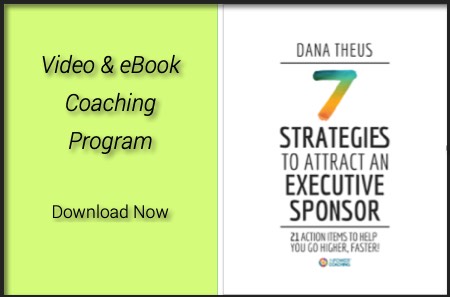In 2011, Women CEO’s in the Fortune 500 made up 14% of the CEO’s according to Catalyst, flat vs. the prior year. Lack of sponsorship appears to be a key factor driving insufficient advancement of women based on a Catalyst study. Men and women have equal number of mentors. However women miss out on sponsors (people who have the power to promote and often use that power and influence to advance careers and opportunities for others). So, the obvious question is: “How do I Get a Sponsor?”
As someone who spent the last 20 years in Corporate America, including the last few in the C-Suite (I was Chief Marketing Officer of a $2Billion company and, as Region President, ran over a $500MM P&L), I have had my share of being sponsored and of sponsoring others. There were many times in my career that my sponsors took risks on me and promoted me, even before I thought I was ready for the job. The following are seven tips on how to get sponsored.
1) Take Charge – I believe that while there is much that corporations can do and are doing to improve sponsorship of women, the accountability for being sponsored lies 100% in the camp of the woman leader. As a sponsor in my organizations, I was much more likely to support men and women who took the initiative to seek me out.
2) Pick the Right Environment – Be smart about seeking workplaces and teams where leaders recognize the importance of promoting smart people, regardless of their gender. Look through the companies that have multiple women on their Boards and on Executive teams. Utilize research from Catalyst and other organizations and tap into your network to discover which companies are making the difference.
3) Make Results Happen – In my career, most of my sponsors found me. To be sponsored, you have to have results. This is a necessary but not a sufficient. The best way to get results is to understand your strengths and use them shamelessly to demonstrate your value. What are you known for doing really well? Sponsors are often current or former bosses who have benefited from the impact you make, so make your impact.
4) Get Noticed – Sponsors often have lots of people in their organization with results, but the number of people they will take risks for and sponsor are limited. Why would they choose you? How do you stand out? Make sure your articulate your personal leadership brand and then market it effectively and authentically (see resources below).
In many organizations your exposure to senior management is fleeting. Make that count! Often, your presentation and communication skills are a somewhat inflated proxy for your talents and abilities. Communicating powerfully (both listening and expressing yourself) are skills that can be learned, so invest in learning them.
5) Take Calculated Risks – A great way to get noticed is your willingness to take risks. Take the high profile assignment even if it is a turnaround situation. Take international assignments. At one point in my career I chose to take an assignment running a $100MM business in Mexico over an assignment running a $1Billion business in the US. That is because I felt the latter, a turnaround situation, although a higher risk, also offered a greater potential to make an impact and be noticed. I also knew that my international background and language skills would be a competitive advantage in the role. International stints give us more exposure and generally are great learning experiences. We can ask ourselves “What are the high profile roles that I feel I can bring my strengths to”?
6) Build Rapport – Research says that people tend to sponsor others who remind them of themselves. Since a lot of people in senior positions are white males, that’s the demographic that gets sponsored more often. However, gender and ethnicity aren’t the only traits that sponsors can identify with. Most of my sponsors were white male and I am an Asian female. I’ve sponsored both men and women. There are other traits that people can see in you that can remind them of themselves. Perhaps it’s your tenacity. Perhaps it’s The bottom line is that they like you because they see themselves in you.
In order for them to like you, they need to get to know you. Many women take themselves out of the running because they choose to not show up and engage with potential sponsors. Don’t be intimidated. “Be curious to get to know them as people and find common ground” is excellent advice given by Penny McIntyre, former Group President at Newell Rubbermaid.
7) Find Meaning & Have Fun – McKinsey research quoted in the book “How Remarkable Women Lead” shows that for women in particular, doing work they believe is meaningful, is a huge driver of engagement and job satisfaction. Many women opt out physically (by leaving) or emotionally (by disengaging from the track to the top) if they don’t connect what they do with what is meaningful for them. So find this connection and re-engage passionately. If you’re relaxed and enjoying the work that you do, the passion and energy you project are palpable. It makes you 100% more confident.
Take charge of your career development and practice 7 strategies to attract an executive sponsor.







